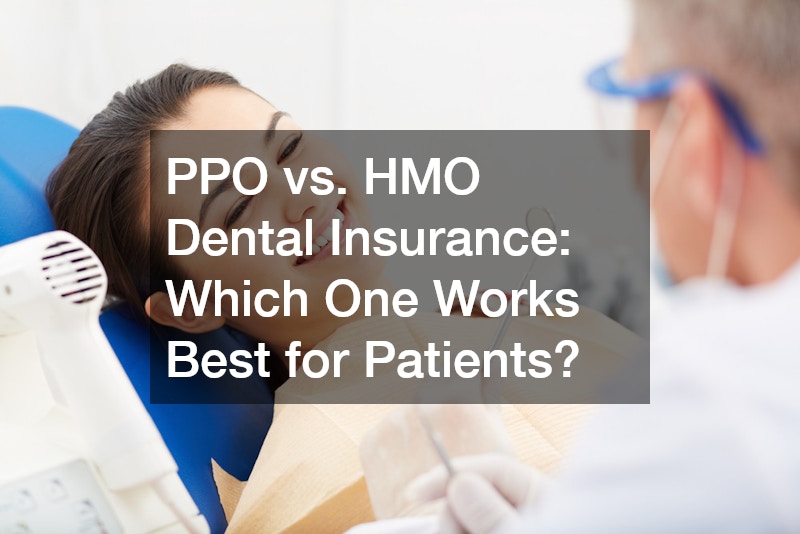
Key Takeaways: PPO vs. HMO Dental Insurance
-
PPO dental insurance offers more flexibility and broader access to providers, but premiums and out-of-pocket costs are higher.
-
HMO dental insurance emphasizes affordability with predictable copays and lower premiums, but limits patients to in-network dentists.
-
Preventive care is usually covered 100% under both plan types, making regular cleanings and exams more affordable.
-
PPOs are better for patients who travel often, want specialist access without referrals, or prefer choice in providers.
-
HMOs are better for budget-conscious patients who are comfortable with a smaller provider network and predictable fees.
-
The best plan depends on individual needs, oral health history, and lifestyle priorities.
Choosing a dental insurance plan is often more complicated than it seems. Patients want coverage that balances affordability with access to quality care from their dentist, but the wide range of plans can leave people feeling overwhelmed. Two of the most common options are Preferred Provider Organization (PPO) and Health Maintenance Organization (HMO) dental insurance plans. Both help reduce the cost of dental visits, but they operate in very different ways.
For patients, the decision between PPO and HMO coverage usually comes down to flexibility, costs, and coverage details. This article will break down the differences between the two, highlight the strengths and weaknesses of each, and provide practical advice on how to choose the right plan for your needs.
Understanding Dental Insurance Basics
Before diving into PPO and HMO plans, it helps to understand how dental insurance works. Unlike medical insurance, which is often designed to cover catastrophic events, dental coverage focuses heavily on preventive care. Most dental insurance plans encourage routine cleanings, exams, and early treatment to avoid costly and painful issues later on.
Common terms patients should know include:
-
Premium – The monthly amount you pay for insurance coverage.
-
Deductible – The amount you must pay out of pocket before insurance kicks in.
-
Copay – A fixed fee you pay at the time of service.
-
Coinsurance – The percentage of treatment costs you’re responsible for after the deductible.
-
Annual Maximum – The maximum amount your dental plan will pay in one year.
Most dental services are categorized as:
-
Preventive: Exams, cleanings, and X-rays.
-
Basic: Fillings, simple extractions, and periodontal treatment.
-
Major: Crowns, dentures, bridges, and sometimes implants.
With these basics in mind, we can better understand the differences between PPO and HMO dental insurance.
What is a PPO Dental Plan?
A PPO, or Preferred Provider Organization, is one of the most flexible types of dental insurance. It gives patients the freedom to choose from a wide network of dentists and even see providers outside of the network, though out-of-network care usually comes with higher costs.
Key features of PPO dental plans:
-
Flexibility: Patients can visit any dentist, in or out of network.
-
Specialist access: Referrals are not required; patients can schedule directly with specialists.
-
Coverage structure: Preventive care is often fully covered, while basic and major services are partially covered after deductibles and coinsurance.
-
Premiums: Typically higher than HMO plans.
Pros of PPO plans:
-
Wide choice of dentists.
-
No need for referrals.
-
Coverage available nationwide, which helps patients who travel often.
-
Higher annual maximums compared to HMOs.
Cons of PPO plans:
-
Higher monthly premiums.
-
Deductibles and coinsurance can add up quickly.
-
Balance billing may occur if you use out-of-network providers.
What is an HMO Dental Plan?
An HMO, or Health Maintenance Organization, is a more structured type of dental insurance. Patients must select a primary dentist from a specific network, and care outside the network is usually not covered, except in emergencies.
Key features of HMO dental plans:
-
Network-based care: Only in-network dentists are covered.
-
Referrals: Patients often need referrals for specialist visits.
-
Cost structure: Lower premiums and little to no deductible.
-
Emphasis on affordability: Predictable copays for specific procedures.
Pros of HMO plans:
-
Lower monthly premiums.
-
No annual maximums in many cases.
-
Predictable costs for common treatments.
-
Encourages preventive care within the network.
Cons of HMO plans:
-
Limited choice of providers.
-
Requires referrals for specialists.
-
May be inconvenient for patients who move or travel frequently.
-
Smaller networks can result in longer wait times.
Cost Comparison Between PPO and HMO Plans
Cost is often the deciding factor for patients choosing between PPO and HMO dental insurance.
PPO Cost Structure:
-
Higher monthly premiums.
-
Deductibles usually range from $50 to $150 per year.
-
Annual maximums often fall between $1,000 and $2,500.
-
Out-of-network care is partially covered, but patients may face balance billing.
HMO Cost Structure:
-
Lower monthly premiums.
-
Minimal or no deductible.
-
No annual maximums—coverage is ongoing but limited to network care.
-
Copays are predictable and clearly outlined in the plan.
Example Scenarios:
-
Routine cleaning and exam: Both PPO and HMO often cover 100%.
-
Filling: PPO may cover 80%, leaving the patient with a 20% coinsurance. HMO typically charges a small copay.
-
Crown: PPO might cover 50% with the patient paying the remainder after deductible. HMO sets a fixed copay, often lower, but only in-network.
Coverage Differences for Common Dental Procedures
Dental plans generally separate services into tiers of coverage. Here’s how PPO and HMO plans compare:
-
Preventive care: Both PPO and HMO plans usually cover cleanings, exams, and X-rays at 100%.
-
Basic services: PPO plans cover a percentage (e.g., 70–80%), while HMO plans use fixed copays.
-
Major services: PPO covers around 50%; HMO has copays, which can sometimes be lower but more restrictive.
-
Orthodontics: PPO plans sometimes cover orthodontics, especially for children, but require a waiting period. HMO plans may cover orthodontics but only with approved in-network providers.
-
Cosmetic dentistry: Generally not covered under either plan.
Flexibility and Access to Care
Flexibility is one of the biggest differences between PPO and HMO dental insurance.
-
PPO: Patients can see any dentist, including specialists, without a referral. Out-of-network care is covered, though costs are higher. Ideal for people who travel frequently or want more provider options.
-
HMO: Patients must use in-network providers and need referrals for specialists. Care outside the network is generally not covered, which limits choice but keeps costs predictable.
Who Benefits Most From PPO Plans?
PPO dental insurance is well-suited for patients who:
-
Want freedom to choose any dentist, even outside the network.
-
Travel frequently or live in multiple locations throughout the year.
-
Have complex dental needs that may require specialists.
-
Are willing to pay higher premiums for flexibility and broader access.
Who Benefits Most From HMO Plans?
HMO dental insurance is a good fit for patients who:
-
Are primarily concerned with affordability.
-
Have predictable, routine dental care needs.
-
Don’t mind staying within a network of providers.
-
Want straightforward, easy-to-understand copays instead of variable coinsurance.
Alternatives and Hybrid Options
For patients who don’t feel PPO or HMO plans fit their needs, other options exist:
-
Discount dental plans: Membership programs that offer reduced rates at participating dentists.
-
Employer-provided insurance: Some workplaces offer hybrid plans with features of both PPO and HMO.
-
HSAs and FSAs: Pre-tax accounts that can be used to pay for dental expenses.
-
Fee-for-service plans: Patients pay upfront and get reimbursed by the insurer, offering maximum flexibility but higher upfront costs.
Questions to Ask Before Choosing a Dental Plan
When evaluating plans, patients should ask:
-
What are the monthly premiums, and what will my yearly cost be?
-
How large is the dentist network in my area?
-
What are the annual maximums, deductibles, and waiting periods?
-
How are emergency dental visits covered, especially while traveling?
-
Does the plan include orthodontics or implants?
-
Are pre-existing conditions or certain treatments excluded?
Choosing between PPO and HMO dental insurance depends on your personal priorities. PPO plans provide flexibility and wider access to care but come at a higher cost. HMO plans emphasize affordability and predictability, but with limited provider choice and stricter rules for accessing specialists.
For patients who value choice and travel often, a PPO may be the better fit. For those who want to keep costs low and don’t mind staying within a network, an HMO is often the smarter option.
Ultimately, the best plan is the one that aligns with your oral health needs, budget, and lifestyle. Before committing, compare plan details, talk with your dentist about network participation, and calculate your potential out-of-pocket expenses. With the right plan, you can protect both your smile and your finances.


